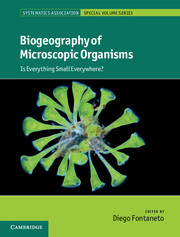Book contents
- Frontmatter
- Contents
- List of contributors
- Preface
- Part I Theoretical framework
- Part II Prokaryotes
- Part III Unicellular eukaryotes
- Part IV Pluricellular eukaryotes
- Part V Processes
- 15 Microbes as a test of biogeographic principles
- 16 A metacommunity perspective on the phylo- and biogeography of small organisms
- 17 Geographic variation in the diversity of microbial communities: research directions and prospects for experimental biogeography
- Index
- Systematics Association Publications
- Systematics Association Special Volumes
- Plate section
- References
15 - Microbes as a test of biogeographic principles
from Part V - Processes
Published online by Cambridge University Press: 05 August 2012
- Frontmatter
- Contents
- List of contributors
- Preface
- Part I Theoretical framework
- Part II Prokaryotes
- Part III Unicellular eukaryotes
- Part IV Pluricellular eukaryotes
- Part V Processes
- 15 Microbes as a test of biogeographic principles
- 16 A metacommunity perspective on the phylo- and biogeography of small organisms
- 17 Geographic variation in the diversity of microbial communities: research directions and prospects for experimental biogeography
- Index
- Systematics Association Publications
- Systematics Association Special Volumes
- Plate section
- References
Summary
Introduction
In the hierarchy of scientific knowledge, a principle, rule or law describes consistent observations and precedes hypothesis and theory. Given consistent observations, other information or insight may suggest mechanisms, and a hypothesis can be formed. For example, the first principle of biogeography, Buffon's law, states that disjunct regions have distinct species assemblages despite similar environments. Buffon proposed a mechanism to explain biogeographic patterns: that species ‘improve’ or ‘degenerate’ according to their environment. Given generality and often incorporating multiple facets, a theory may emerge that explains the patterns well (e.g. evolutionary theory).
As in ecology, biogeographic principles may include speculations that ‘have often been elevated to laws merely by the passing of time’ (Loehle, 1987). Tests of biogeographic laws/principles/rules are thus valuable for biogeography in general and for understanding the tested system.
In that context, the statement for microbes that ‘Everything is everywhere, but the environment selects’ (Finlay, 2002; de Wit and Bouvier, 2006; hereafter abbreviated as EiE) is valuable to test the generality of biogeography's principles and their hypothesised mechanisms. Generality is tested best by extremes, and microbes (defined here as < ~1–2 mm; Finlay, 2002) certainly represent the lower margin of body size for most biogeographic evidence because most biogeography research has been conducted with macrobes (defined here as larger than 1–2 mm; Finlay, 2002). According to EiE, microbes have no biogeographic pattern due to their enormous population sizes and high probability of ubiquitous dispersal (Finlay, 2002).
- Type
- Chapter
- Information
- Biogeography of Microscopic OrganismsIs Everything Small Everywhere?, pp. 309 - 323Publisher: Cambridge University PressPrint publication year: 2011
References
- 9
- Cited by



